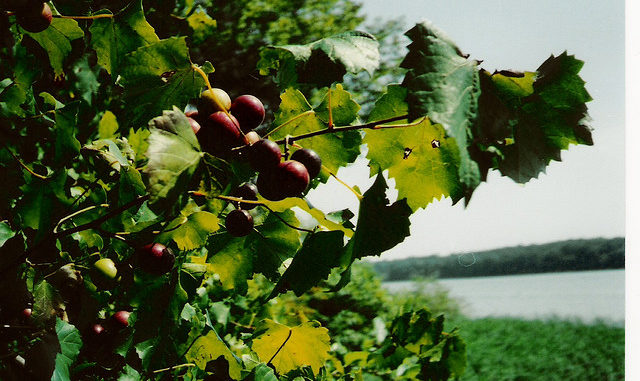
Berries harvested in South La for centuries
The LSU AgCenter contributed to this report. Visit www.lsuagcenter.com for more information on muscadine grapes in Louisiana.
Over the river and through the woods, now is the time to go on the hunt for muscadine grapes.
The small purple berries are called the “grape of the south” because they grow naturally almost anywhere throughout the southern states, especially Louisiana.
“They’re adapted to pretty much all of the various climates that we have here in Louisiana,” said Rene’ Schmit, LSU AgCenter County Agent. “You can certainly find them in abundance in wooded areas throughout the state.”
The first reported variety of muscadine grape was found as early as 1554 by Sir Walter Raleigh’s colony in North Carolina. Since then, the wild grape has been gathered from swamps to forests in Louisiana for centuries and can be used to make delicious jellies, jams, preserves and wine.
When searching for the grapes, look for 1/2- to 1-inch berries with a dull, dark purple color and tough skin. If you don’t want to go hunting for the berries, there are multiple farms throughout Louisiana where you can pick the fruit in a more controlled environment.
You can also check out farmers’ markets for local crops of muscadines.
Once you find your muscadine grapes, try freezing them to make tasty recipes all year.
Muscadines are usually cooked and the juice, hulls and pulp are frozen, but grapes can be frozen whole as well. The first method will keep grapes good for up to three years while freezing whole grapes will work for about one year.
To get get the grapes recipe-ready, prepare and cook them.
De-seed the grapes by pressing them between your fingers – the pulp will fall out leaving hulls. Cook the hulls. Heat the pulp and put it through a sieve to remove seeds. Each quart of whole grapes yields about two cups of hulls.
Once you have a good amount ready for cooking, try some great recipes for a real Louisiana treat.
Muscadine Preserves
6 cups cooked hulls and pulp
2 tablespoons lemon juice
1 box powdered fruit pectin
7 ½ cups sugar
De-seed muscadines and cook hulls and pulp.
Put hulls and pulp in a saucepan and cover with three parts water, one part muscadine juice.
Cover and boil gently for 15 minutes or until hulls are tender.
Mix pectin with fruit and lemon juice in a large kettle. Place over high heat and stir until mixture comes to a hard boil. Add sugar all at once. Stir until sugar dissolves, bring to a full rolling boil for one minute, stirring constantly. Remove from heat and skim off foam. Pour into sterilized jelly jars; seal and process for five minutes in a boiling water bath canner.
After 30 minutes, invert or shake to prevent floating fruit.
Muscadine Bread
1/2 cup margarine
1 cup sugar
2 eggs
2 cups sifted flour
¼ teaspoon salt
1 ½ teaspoons baking powder
½ cup milk
½ cup muscadine sauce
½ cup chopped pecans
To make sauce:
Bring 7 ½ cups cooked hulls and juice, 6 cups sugar and ½ teaspoon salt to a rapid boil for about 15 minutes, stirring often.
Add ½ cup vinegar and boil five more minutes. Stir in 3 ¾ teaspoons of a mixture of mace, cinnamon, allspice and cloves.
Cream margarine; add sugar gradually, beating well. Add eggs one at a time.
Sift dry ingredients together and add alternately with milk. Stir in muscadine sauce and pecans.
Bake in greased and floured loaf pan at 350 degrees for about 45 minutes. Serves 16.
Luscious Muscadine Syrup
1 ¼ cups juice
1 ½ cups sugar
¼ cup white corn syrup, or 1 ¾ cups sugar
1 tablespoon lemon juice
Mix ingredients in saucepan and stir to dissolve sugar. Bring to a full rolling boil for 3-4 minutes.
Remove from heat and skim; pour into sterilized jars or bottles.
Using part corn syrup adds thickness without extra sweetness. Makes two half-pints.




Be the first to comment